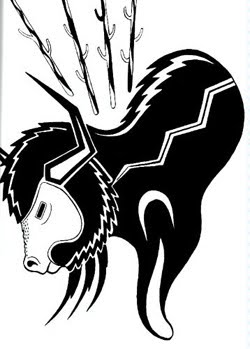"The Way to Rainy Mountain" by N. Scott Momaday is uniquely organized; it has three narrative voices per every two-page chapter. Throughout the book, the first narrative voice tells the Kiowa legends. Next, on the facing page, Momaday gives a paragraph of historical context that relates to the legend. Lastly, below the history, the author gives the reader a glimpse into his life by relating a personal or family experience. Since some of the Kiowa legends and history intertwine with Momaday's own family history, this three-voice narration allows the author to provide great depth and detail about the Kiowa way of life in very few words.
This book is divided into three main sections. The first of the three, "The Setting Out," contains chapters about the legends of the origins of the Kiowa people. These legends are coupled with historical accounts of the earliest Kiowa tribes. This section also describes the basic components of Kiowa culture such as the significance of plants, animals, and the early Kiowa people. It also covers Momaday's first encounters with ancient, sacred Kiowa religious rituals and practices as a child.
The second section, "The Going On," chronicles the interactions of the Kiowas among themselves, as well as with other tribes. The legends cover arrow-makers, women, children, and families. The historical context is slightly removed, and tends to describe the Kiowas from an outside perspective in this section. Again, however, Momaday's narration tells of his own personal experiences with his people, mostly from his childhood.
The final section, titled "The Closing In," has chapters that describe the dwindling and eventual disappearance of the Kiowa culture and life as newer, larger cultures took over. The historical and personal narration of this section deal almost exclusively with Momaday's ancestors and their ties to their culture and their land.
skip to main |
skip to sidebar

Reading Group Project: The Way to Rainy Mountain
Contributors: Tami Booth, Brad Peatross, & Mallory Muse
Our Goal:
Our website was designed to explore N. Scott Momaday's book "The Way to Rainy Mountain." We chose topics that would help generate discussion and analysis in a book club setting.
Illustration by Al Momaday

Photo Sources:
http://www.achievement.org/autodoc/page/mom0gal-1
Copyright (c) Reading Group Project: The Way to Rainy Mountain - Blogger Templates created by Deluxe Templates - Wordpress by Newwpthemes.com
Powered by Blogger